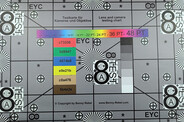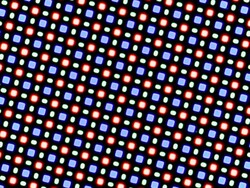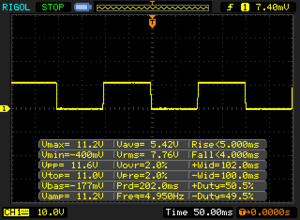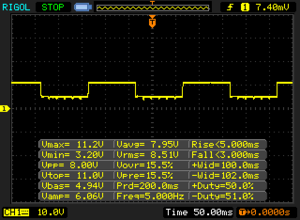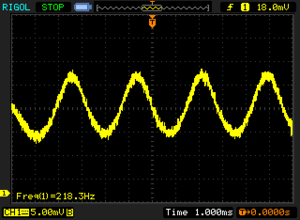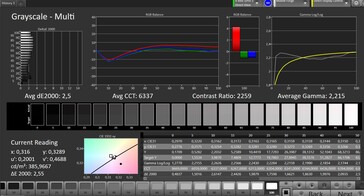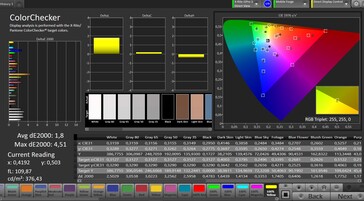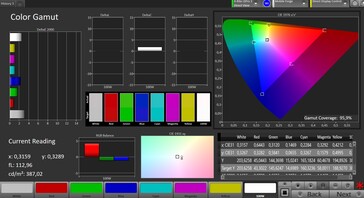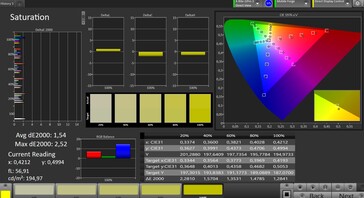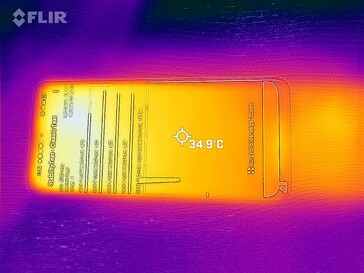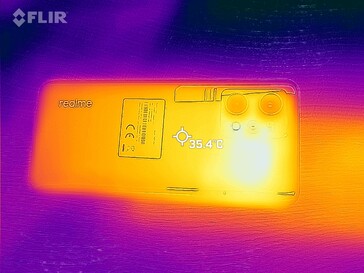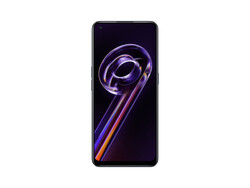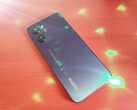realme 9 Pro Plus Smartphone Review - Lots of performance and decent low-light photography ↺
Possible competitors in comparison
Rating | Date | Model | Weight | Drive | Size | Resolution | Price |
|---|---|---|---|---|---|---|---|
| 84.1 % v7 (old) | 03 / 2022 | Realme 9 Pro Plus Dimensity 920, Mali-G68 MP4 | 182 g | 128 GB UFS 2.2 Flash | 6.40" | 2400x1080 | |
| 82.2 % v7 (old) | 04 / 2021 | Realme 8 Pro SD 720G, Adreno 618 | 176 g | 128 GB UFS 2.1 Flash | 6.40" | 2400x1080 | |
| 83.1 % v7 (old) | 07 / 2021 | OnePlus Nord CE 5G (Nord Core Edition) SD 750G 5G, Adreno 619 | 170 g | 256 GB UFS 2.1 Flash | 6.43" | 2400x1080 | |
| 86 % v7 (old) | 05 / 2021 | Xiaomi Poco F3 SD 870, Adreno 650 | 196 g | 128 GB UFS 3.1 Flash | 6.67" | 2400x1080 | |
| 85.1 % v7 (old) | 09 / 2021 | Samsung Galaxy A52s 5G SD 778G 5G, Adreno 642L | 189 g | 128 GB UFS 2.1 Flash | 6.50" | 2400x1080 |
Case and features - Unusual colors
The realme 9 series is supposed to offer good features for the money. The realme 9 Pro Plus is priced around 400 Euros (~$443) and is available in two configurations:
- realme 9 Pro+ with 6 GB RAM and 128 GB mass storage: 380 Euro (~$420)
- realme 9 Pro+ with 8 GB RAM and 256 GB mass storage: 430 Euro (~$476)
The manufacturer offers three colors for its smartphone: Aurora Green, a dark green, Midnight Black, a velvety blue shimmering black, and Sunrise Blue, a bright blue that is the most unusual color with a coating that fades under sunlight. You also only get the small memory variant in Sunrise Blue.
The case itself is made of plastic and the glossy back is very susceptible to fingerprints. The stability is convincing, even stronger finger pressure does not get through to the screen. The workmanship is also clean and without noticeable edges.
A 3.5 mm jack for sound output with Hi-Res certification is also available, as is NFC, and you can measure your heart rate via the fingerprint sensor as a small extra.
Communication, software and operation - Modern operating system with bloatware
The realme 9 Pro Plus proves to be snappy in our WLAN test with the reference router Asus GT-AXE11000, but the speed is not quite as stable; there are drops in the data rate every now and then. Of course, it is a 5G smartphone and many 4G frequencies are also supported, so you can most likely use the mobile Internet while traveling.
The realme UI 3 is based on Android 12, the security patches are from February 2022 at the time of testing and thus quite up-to-date. Some preinstalled third-party apps like shopping portals have to be accepted, but they can be deleted without any problems. It is nice that realme has taken care of a DRM-L1 certification, so you can also watch streaming videos in HD.
The 90 Hz screen can be operated smoothly. The surface is covered with a protective film, but the finger glides pleasantly easily on it as well. The fingerprint sensor integrated into the screen reacts quickly to a placed finger. As soon as the smartphone is lifted, the icon indicating the scanner's position is visible even in standby. The sensor responds to activation after a fairly short wait and unlocks the device reliably. However, it is located quite far down on the screen, which takes some getting used to.
| Networking | |
| iperf3 transmit AX12 | |
| Xiaomi Poco F3 | |
| Samsung Galaxy A52s 5G | |
| Realme 8 Pro | |
| OnePlus Nord CE 5G (Nord Core Edition) | |
| iperf3 receive AX12 | |
| Xiaomi Poco F3 | |
| Samsung Galaxy A52s 5G | |
| OnePlus Nord CE 5G (Nord Core Edition) | |
| Realme 8 Pro | |
| iperf3 receive AXE11000 | |
| Realme 9 Pro Plus | |
| iperf3 transmit AXE11000 | |
| Realme 9 Pro Plus | |
Cameras - Otherwise average camera is good in low light
A Sony IMX776 with optical image stabilization serves as the main sensor of the mid-range phone. It has a resolution of 50 megapixels. The effective resolution is reduced to 12 megapixels via pixel binning, which creates larger and thus more light-sensitive pixels on the sensor.
The image sharpness is in the average range in our test shots, but brightening and color reproduction are good. With low light and high contrasts, the smartphone produces warm, sometimes quite detailed pictures.
The wide-angle camera has 8 megapixels and is on the usual level: A lot is lost when you go a bit more into detail, but the pictures are good for overview shots. Realme has also installed its own macro lens with a meager 2 megapixels, which takes decent close-ups.
On the front, there is also a selfie camera with 16 megapixels. The pictures could be a bit brighter and show more details in dark areas.
Image comparison
Choose a scene and navigate within the first image. One click changes the position on touchscreens. One click on the zoomed-in image opens the original in a new window. The first image shows the scaled photograph of the test device.
Main camera PlantMain camera EnvironmentMain camera Low LightWide-angle camera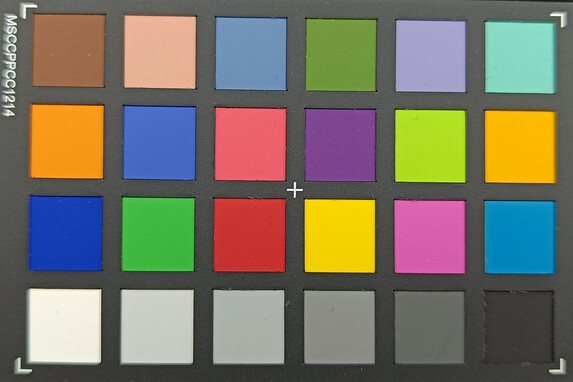
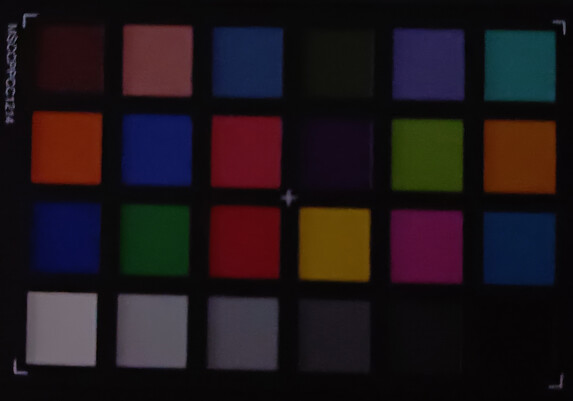
Display - Good color reproduction
AMOLED displays are now something completely normal even in the mid-range. The realme 9 Pro+ offers the typical Full HD resolution, but the brightness is more even than in the predecessor. However, those who are looking for high peak brightness will have to look at Xiaomi or Samsung; the screen in the realme phone cannot keep up.
In return, the display accuracy of the colors is quite good and the response times are also convincing.
| |||||||||||||||||||||||||
Brightness Distribution: 98 %
Center on Battery: 550 cd/m²
Contrast: ∞:1 (Black: 0 cd/m²)
ΔE ColorChecker Calman: 1.8 | ∀{0.5-29.43 Ø4.78}
ΔE Greyscale Calman: 2.5 | ∀{0.09-98 Ø5}
95.9% sRGB (Calman 2D)
Gamma: 2.215
CCT: 6337 K
| Realme 9 Pro Plus AMOLED, 2400x1080, 6.4" | Realme 8 Pro AMOLED, 2400x1080, 6.4" | OnePlus Nord CE 5G (Nord Core Edition) AMOLED, 2400x1080, 6.4" | Xiaomi Poco F3 AMOLED, 2400x1080, 6.7" | Samsung Galaxy A52s 5G AMOLED, 2400x1080, 6.5" | |
|---|---|---|---|---|---|
| Response Times | 17% | 64% | 64% | -7% | |
| Response Time Grey 50% / Grey 80% * (ms) | 8 ? | 8 ? -0% | 3.6 ? 55% | 3.6 ? 55% | 10 ? -25% |
| Response Time Black / White * (ms) | 9 ? | 6 ? 33% | 2.4 ? 73% | 2.4 ? 73% | 8 ? 11% |
| PWM Frequency (Hz) | 218.3 | 114.7 | 373.1 ? | 490.2 ? | 231.5 |
| Screen | -50% | 7% | 46% | 6% | |
| Brightness middle (cd/m²) | 550 | 581 6% | 590 7% | 889 62% | 736 34% |
| Brightness (cd/m²) | 558 | 563 1% | 596 7% | 902 62% | 751 35% |
| Brightness Distribution (%) | 98 | 86 -12% | 97 -1% | 95 -3% | 96 -2% |
| Black Level * (cd/m²) | |||||
| Colorchecker dE 2000 * | 1.8 | 4.34 -141% | 1.9 -6% | 0.9 50% | 2.18 -21% |
| Colorchecker dE 2000 max. * | 4.51 | 7.15 -59% | 3.8 16% | 1.9 58% | 5.69 -26% |
| Greyscale dE 2000 * | 2.5 | 4.9 -96% | 2.1 16% | 1.3 48% | 2.1 16% |
| Gamma | 2.215 99% | 2.327 95% | 2.13 103% | 2.26 97% | 2.27 97% |
| CCT | 6337 103% | 7658 85% | 6698 97% | 6614 98% | 6563 99% |
| Total Average (Program / Settings) | -17% /
-34% | 36% /
21% | 55% /
51% | -1% /
3% |
* ... smaller is better
Display Response Times
| ↔ Response Time Black to White | ||
|---|---|---|
| 9 ms ... rise ↗ and fall ↘ combined | ↗ 5 ms rise | |
| ↘ 4 ms fall | ||
| The screen shows fast response rates in our tests and should be suited for gaming. In comparison, all tested devices range from 0.1 (minimum) to 240 (maximum) ms. » 24 % of all devices are better. This means that the measured response time is better than the average of all tested devices (20.2 ms). | ||
| ↔ Response Time 50% Grey to 80% Grey | ||
| 8 ms ... rise ↗ and fall ↘ combined | ↗ 5 ms rise | |
| ↘ 3 ms fall | ||
| The screen shows fast response rates in our tests and should be suited for gaming. In comparison, all tested devices range from 0.165 (minimum) to 636 (maximum) ms. » 19 % of all devices are better. This means that the measured response time is better than the average of all tested devices (31.6 ms). | ||
Screen Flickering / PWM (Pulse-Width Modulation)
| Screen flickering / PWM detected | 218.3 Hz | ||
The display backlight flickers at 218.3 Hz (worst case, e.g., utilizing PWM) . The frequency of 218.3 Hz is relatively low, so sensitive users will likely notice flickering and experience eyestrain at the stated brightness setting and below. In comparison: 53 % of all tested devices do not use PWM to dim the display. If PWM was detected, an average of 8108 (minimum: 5 - maximum: 343500) Hz was measured. | |||
Performance, emissions and battery life - power galore in the realme phone
The MediaTek Dimensity 920 is a SoC from 2020, but convinces with quite high performance in our benchmarks. Only the Xiaomi Poco F3 with Snapdragon 870 can provide even more power among our similarly priced comparison devices. The graphics performance shows a significant leap compared with the realme 8 Pro. Again, the comparison device from Xiaomi is significantly faster.
In terms of memory, the realme 9 Pro+ proves to be fast thanks to UFS 2.2, but it is not quite up there in the price range. Again it is the Xiaomi Poco F3, which offers even more.
The temperatures on the casing of the realme 9 Pro Plus can rise up to 44.5 °C (112.1 °F) during longer load. That is not problematic in itself, but the temperature increase could be much higher on a hot summer day and thus become unpleasant.
The maximum volume of the stereo speakers is quite high, but the sound is balanced and you can listen to a piece of music. External audio devices can also be connected via Bluetooth and the 3.5 mm jack.
The realme phone cannot quite keep up with the predecessor in terms of battery life, but it still does quite well in the class comparison with just under 16 hours in our WLAN test. The phone can be charged with up to 60 watts, and a corresponding charger is included. The manufacturer promises 50% in 15 minutes. Even if it takes us a few minutes longer, we are very pleased with the charging speed.
| Realme 9 Pro Plus | Realme 8 Pro | OnePlus Nord CE 5G (Nord Core Edition) | Xiaomi Poco F3 | Samsung Galaxy A52s 5G | Average 128 GB UFS 2.2 Flash | Average of class Smartphone | |
|---|---|---|---|---|---|---|---|
| AndroBench 3-5 | -52% | -2% | 24% | 0% | -0% | 142% | |
| Sequential Read 256KB (MB/s) | 991 | 474 -52% | 951 -4% | 1378 39% | 951 -4% | 736 ? -26% | 2226 ? 125% |
| Sequential Write 256KB (MB/s) | 474.9 | 191.7 -60% | 466 -2% | 684 44% | 486.5 2% | 532 ? 12% | 1848 ? 289% |
| Random Read 4KB (MB/s) | 173.5 | 98.5 -43% | 187.6 8% | 208 20% | 168.2 -3% | 193 ? 11% | 295 ? 70% |
| Random Write 4KB (MB/s) | 182.1 | 84.8 -53% | 168.1 -8% | 170.6 -6% | 192.5 6% | 186.3 ? 2% | 335 ? 84% |
Temperature
(±) The maximum temperature on the upper side is 44.5 °C / 112 F, compared to the average of 35.2 °C / 95 F, ranging from 21.9 to 247 °C for the class Smartphone.
(±) The bottom heats up to a maximum of 42.7 °C / 109 F, compared to the average of 34 °C / 93 F
(+) In idle usage, the average temperature for the upper side is 31.7 °C / 89 F, compared to the device average of 32.9 °C / 91 F.
Speaker
Realme 9 Pro Plus audio analysis
(+) | speakers can play relatively loud (91.6 dB)
Bass 100 - 315 Hz
(-) | nearly no bass - on average 22.3% lower than median
(±) | linearity of bass is average (12.7% delta to prev. frequency)
Mids 400 - 2000 Hz
(±) | higher mids - on average 7% higher than median
(+) | mids are linear (4.6% delta to prev. frequency)
Highs 2 - 16 kHz
(±) | higher highs - on average 6.4% higher than median
(+) | highs are linear (6.5% delta to prev. frequency)
Overall 100 - 16.000 Hz
(±) | linearity of overall sound is average (23.3% difference to median)
Compared to same class
» 52% of all tested devices in this class were better, 7% similar, 41% worse
» The best had a delta of 11%, average was 35%, worst was 134%
Compared to all devices tested
» 69% of all tested devices were better, 5% similar, 25% worse
» The best had a delta of 4%, average was 24%, worst was 134%
Realme 8 Pro audio analysis
(+) | speakers can play relatively loud (84.7 dB)
Bass 100 - 315 Hz
(-) | nearly no bass - on average 32.3% lower than median
(±) | linearity of bass is average (11% delta to prev. frequency)
Mids 400 - 2000 Hz
(+) | balanced mids - only 4.5% away from median
(+) | mids are linear (5.4% delta to prev. frequency)
Highs 2 - 16 kHz
(+) | balanced highs - only 3% away from median
(+) | highs are linear (4.1% delta to prev. frequency)
Overall 100 - 16.000 Hz
(±) | linearity of overall sound is average (22.8% difference to median)
Compared to same class
» 50% of all tested devices in this class were better, 6% similar, 44% worse
» The best had a delta of 11%, average was 35%, worst was 134%
Compared to all devices tested
» 67% of all tested devices were better, 6% similar, 28% worse
» The best had a delta of 4%, average was 24%, worst was 134%
Battery life
| Realme 9 Pro Plus 4500 mAh | Realme 8 Pro 4500 mAh | OnePlus Nord CE 5G (Nord Core Edition) 4500 mAh | Xiaomi Poco F3 4520 mAh | Samsung Galaxy A52s 5G 4500 mAh | Average of class Smartphone | |
|---|---|---|---|---|---|---|
| Battery Runtime | ||||||
| WiFi Websurfing (h) | 15.9 | 16.8 6% | 15.4 -3% | 13.4 -16% | 12 -25% | 19.3 ? 21% |
Pros
Cons
Verdict - Solid phone without major weaknesses
The realme 9 Pro Plus is a very solid mid-range phone that offers everything you would expect in this price range: A fast screen, fast charging, decent runtimes, fast storage, a lot of system power and a flexible camera system.
The chassis has a decent build, but does not stand out from the crowd. The clearly arranged system software is convincing except for the preinstalled bloatware. The many photography modes like tilt-shift or star mode are good, but the camera quality is only average overall. The Wi-Fi data rates also fluctuated a bit in the test.
The realme 9 Pro+ is a solid mid-range phone with a lot of performance and fast charging.
If all that is not enough, you will have to buy the Xiaomi Poco F3, which currently still offers the best price-performance ratio. Samsung's Galaxy A52s 5G also has good performance rates, but disappoints with a slow charging speed via the included power adapter.
Price and availability
You can buy the 9 Pro+ directly from realme. At the time of testing there is a realme pad for free with the purchase. At amazon.de, Cyberport and notebooksbilliger.de you can get the smartphone without the extra charge, but a bit cheaper.
Realme 9 Pro Plus
- 08/30/2022 v7 (old)
Florian Schmitt











